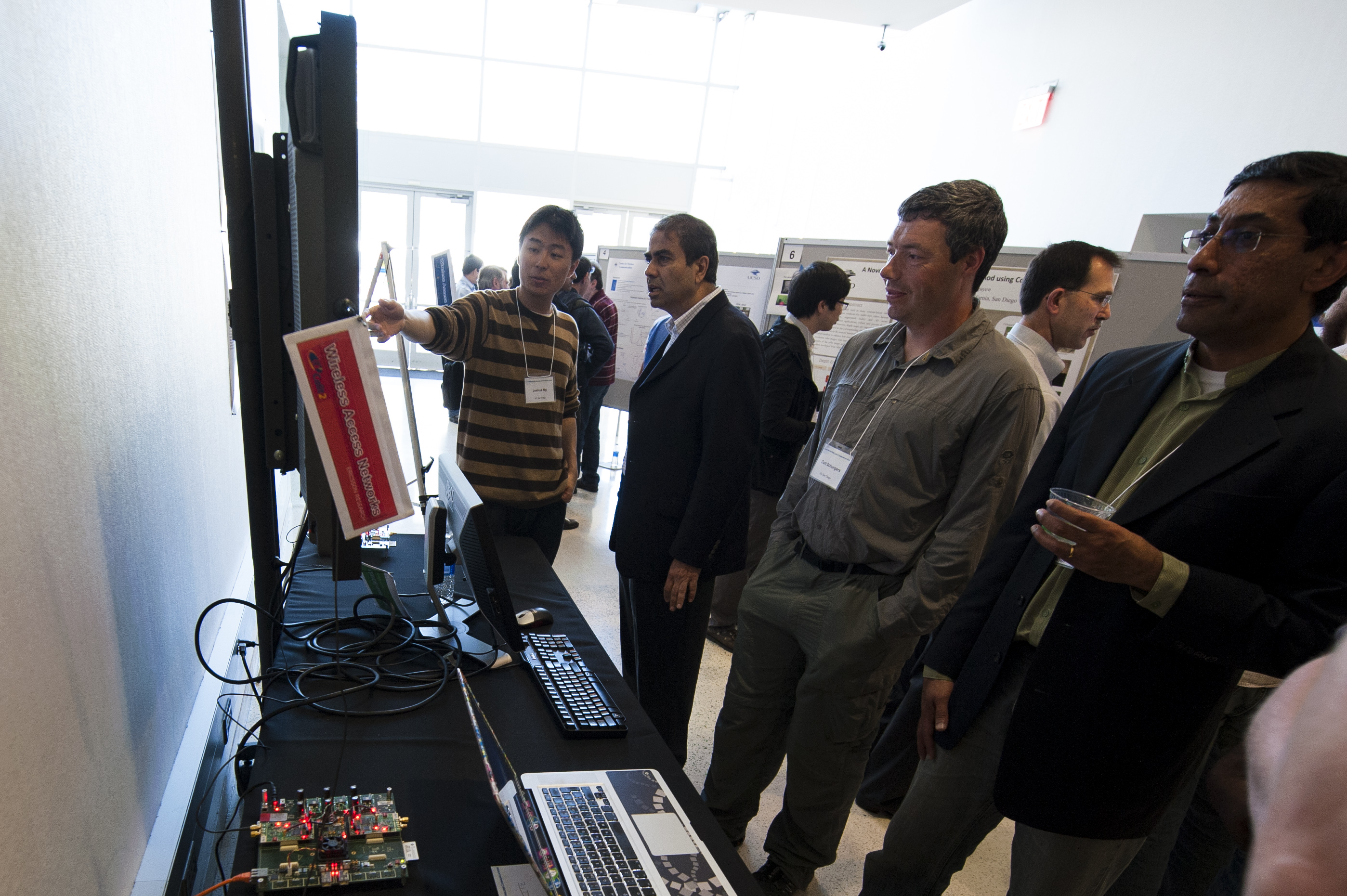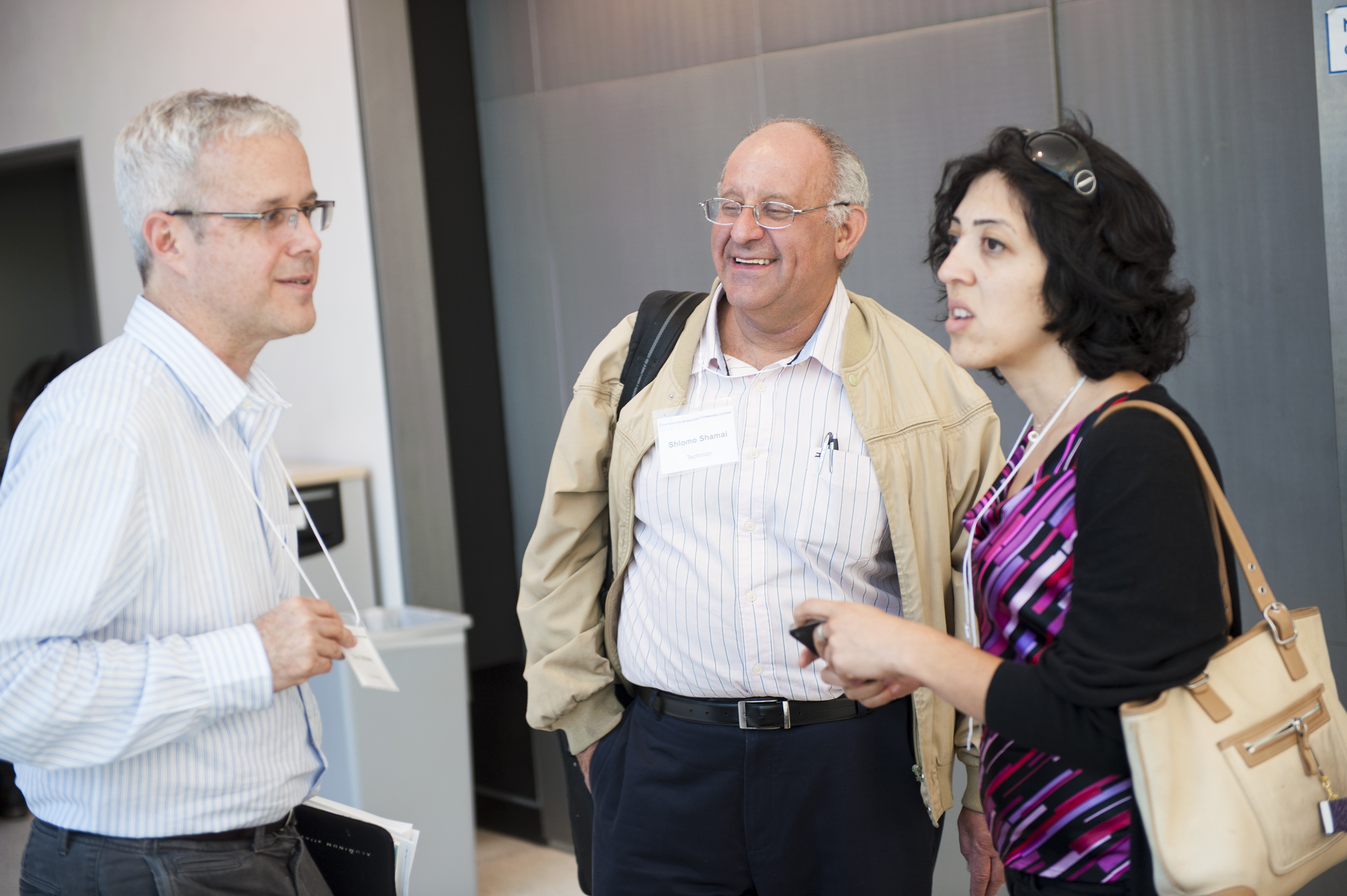Center for Wireless Communications Convenes Innovators in Academia, Industry for Research Review
San Diego, Calif., May 30, 2012 — A research review held by the University of California, San Diego Center for Wireless Communications (CWC) convened researchers from academia and industry to get a look at what’s right around the corner in terms of cellular and wireless communications, and what’s still a bit farther down the road.
|
The CWC, which is affiliated with the UC San Diego Jacobs School of Engineering, relies upon a strong university-industry partnership to produce a relevant program of systems- and technology-oriented research. Its 40 affiliated faculty members pursue research in low-power circuitry, smart antennas, communication theory, communication networks and multimedia applications. A unifying theme at the CWC is Broadband Wireless, i.e., approaches for extending capabilities and services wireless mobile domains.
This year’s research review, which was held earlier this month at the California Institute for Telecommunications and Information Technology, or Calit2 (one of CWC’s academic partners), attracted about 160 participants from the University and from the many wireless communications industry partners that support the center, including Ericsson, Nokia Siemens Networks, Huawei, Qualcomm and ViaSat, as well as visiting representatives from Verizon Wireless, Entropic, InterDigital, Spawar and SAIC.
One new element at this year’s review was a trio of technology demos presented at the event poster session by faculty and graduate students affiliated with CWC. Rounding out the agenda was a series of talks given by researchers from UCSD, Israel’s Technion University and various industries. A lecture titled “Beyond 4G Communications” by Amitava Ghosh, head of Wireless Broadband Innovation for Nokia Siemens Networks, predicted that by the year 2020, wireless broadband networks will need to support up to 1,000 times more traffic. Ghosh added that Nokia Siemens Networks expects to have 380 million subscribers alone by 2015, making wireless broadband the “fastest growing utility service.”
What’s more, the networks will have to provide “rock solid, ubiquitous connectivity at gigabit-per-second speeds with millisecond latency” in order to support emerging smartphones, innovative apps and other technologies like 3D standard-definition video, 3D high-definition video and ultra HD.
To accommodate such speed and efficiency, Ghosh called for increased proliferation of what he dubbed “hetnets” — heterogenous networks of macrocells, microells, pico and femtocells and other access points that combine the benefits of wide and local areas of connectivity.
“We need a means to increase spectral efficiency, and that will require a mix of solutions to meet the necessary requirements: More spectrum and new bands, more base stations with hetnets, etc.," Ghosh explained. “The number of cellular base stations will grow to over 50 million by 2020, and by 2020, there can be 10 times more spectrum available below 6 gigahertz, if we drive for it beyond 4G requirements.
Ghosh also called for new ways for managing traffic based on peak demand.
“Capacity demand varies with the time of the day, so why not take advantage of that?” he asked. “Instead of designing base station to serve constant capacity, why not build them so they can ‘trunc’ [truncate] capacity to another base station where it is needed?”
|
Shlomo Shamai of Technion University presented a lecture at the review on research and applications in the field of Information Theory and Communications. Shamai is the 2011 recipient of the Claude E. Shannon Award, which is presented each year by the Institute of Electrical and Electronics Engineers (IEEE) Information Theory Society. Shamai is also a fellow of IEEE, and was honored the previous day as the UC San Diego Center for Magnetic Recording Research’s annual Shannon Memorial Lecturer.
A talk by UCSD researcher Sujit Dey focused on “Enabling Personalized and Interactive Video Services” — research that, as Dey noted, stems from two major future trends: personalized videos and content recommendations. Dey explained that for recommendations to be relevant and as accurate as possible, service providers must have some knowledge of a user’s preferences and be able to classify videos watched (either as videos related to certain events, music genres, sports teams, etc.) to enable a good match with the user preference.
Dey said that his research team has been able to achieve 76 percent accuracy by using a set of automated scalable techniques using contextual information (information found on a webpage) to classify videos in real-time and then create a “dial” of user preferences from the categories of videos they have previously watched.
Another CWC researcher from UCSD, Tara Javidi, presented a talk on “Delay Sensitive Networking” which presented methods for communicating information that is time-sensitive In particular, her research addresses how to minimize the communication delay by optimally allocating communication resources across the network. Examples included allocating radio frequency sub-carriers to various users in a cellular network, transmission time allocation among wifi users, or relay selection in a multihop networks.
“This could, for example, be very useful for an inter-vehicular communication network which enables communication amongst a group of cars” explained CWC Director Alon Orlitsky. “Knowing the location, speed, and arrangement of other vehicles and the road ahead can significantly improve the road safety for travelers, but this is contingent on real-time communication, with minimum delay.”
The event also included a talk on “Real-Time 3D Video Processing” by UCSD researcher Truong Nguyen.
“Truong’s research was on how to do 3D visualization without needing 3D glasses,” explains Orlitsky. “To convert an image into 3D, you need to create several images of the same scene, and the way Truong does that is by using a depth map to try to estimate, in real-time, the depth of different objects. That enables 3D multiview, which means people can be standing in different locations but all of them are seeing the image in 3D.”
Nguyen also submitted a version of his research (customized for wireless channels) to the InterDigital Innovation Challenge, a collaboration between InterDigital and Calit2 to seek out wireless innovations. Nguyen and his team are finalists in the competition (the winners will be announced in September).
Related Links
Center for Wireless Communication
Media Contacts
Tiffany Fox, (858) 246-0353, tfox@ucsd.edu


